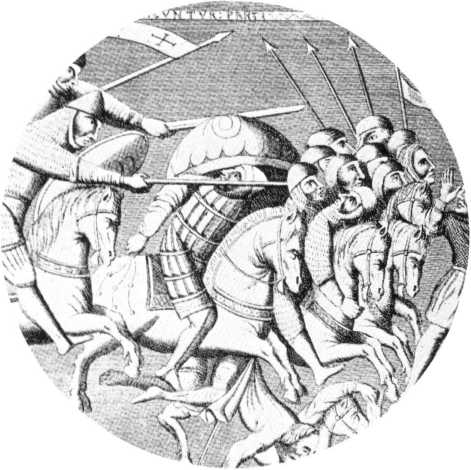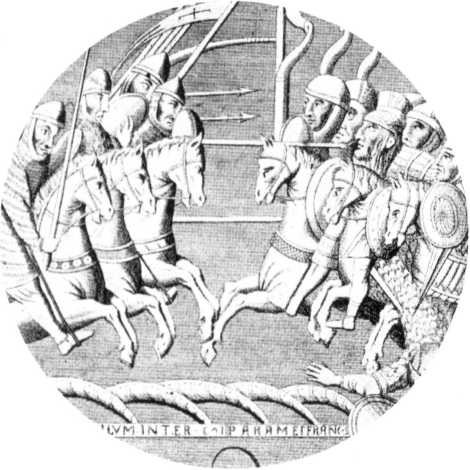m750

Part of the painted Windows of St Denys, near Paris, now lost but preserved in the i8th-century illustrations by Montfaucon. The windows were painted in the i2th century and the two reproductions show scenes from the ist Crusade. On the right of each picture are Seljuks, which the medieval artist has shown as closely resembling Europeans, a common practice of the period and presumably due to lack of accurate infor-mation. However, an attempt has been madę on one figurę in each picture to portray the lamellar armour wora by the Seljuks in the crusading era.

such men, wearing thcir everyday clothes. The man illustrated also has a smali targe and a sword, though his real role remained purely to supply missile fire before a battle or at sieges.
Ci Knight c. i225-60
Major changes began to take place in the igth century as the knight sought better protection. Mail was a good defence generally speaking, but it could not always stop a lance thrust, nor a good swing with an axe or sword. Wearing a gambeson beneath the hauberk was a common extra defence of the 12th century (part of it can be seen where the hauberk is slit at the front on this figurę) but by about 1225 the richer knights were beginning to wear an additional defence over the hauberk. The straps of this defence, which was known as a cuirie, can just be seen by the arm of the knight.
The cuirie was probably of cuir bouilli—leather boiled in wax and then shaped—and may some-times have been reinforced by metal plates. Evidence of the cuirie'’s form is scanty, as surcoats conceal most ofit, but it was probably quite short, sleeveless, and comprised a front and back ‘piąte’ with fiaps extending round the sides, where they were strapped together.
By about 1225, too, the kite-shaped shield often had a fiat upper edge and was less concave; by mid-century it was beginning to assume the shorter form now known as the ‘heater’ shield, from its re-semblance to a fiat iron.
The knight also wears prick spurs, which remained the only form of spur during the I2th and I3th centuries; and under his mail coif he wears an arming cap, which was simply the civilian cap of the period with a roli of padding round the brow, and served to protect the head and hołd in position the helmet illustrated. Some pot helms had had face guards added from 1180 onwards, and such guards were in generał use by about 1210. By 1220 the head was completely encased in the type of helmet illustrated, known as the ‘great hełm’ or heaume. These helmets were padded inside but do not appear to have been secured under the chin, and that roli on the arming cap (first introduced about 1200) may have played a vital role in keeping the helmet in place.
Wyszukiwarka
Podobne podstrony:
N/UBłf The Real Chinese You Were Never Taught in School EVEUNE CHAO Illustrations by Chris Murphy ©
img 014 " WISN 8F.CURKT) ONP. KITO OF T!1F. CABI.E TO TH AT PART OF THE BOOM BKSTIKO AC A IN ST
img 014 " WISN 8F.CURKT) ONP. KITO OF T!1F. CABI.E TO TH AT PART OF THE BOOM BKSTIKO AC A IN ST
MR293R190(8 1 REPITTING the ends of the cord project frora the groove at the lower part of the windo
więcej podobnych podstron